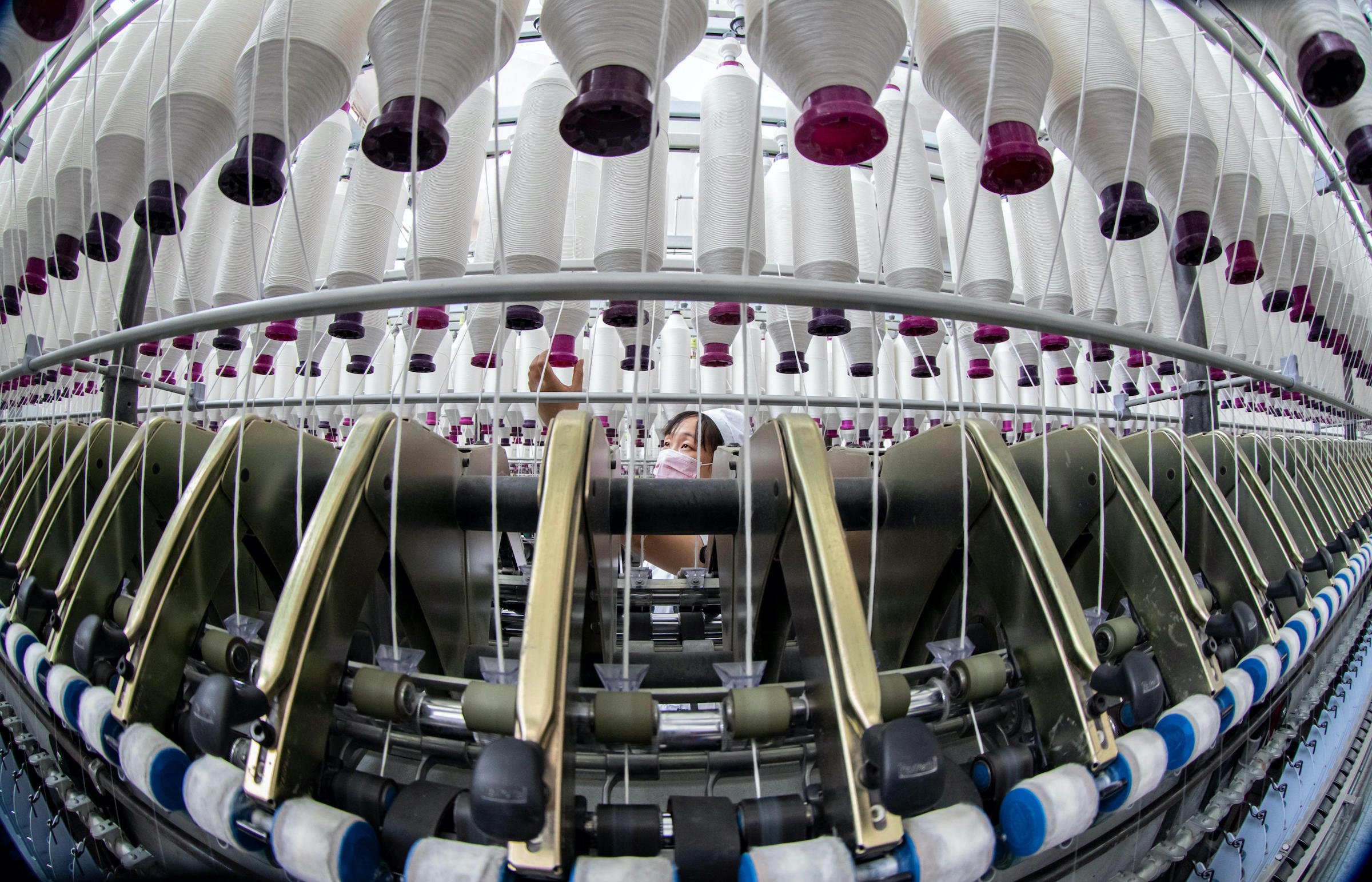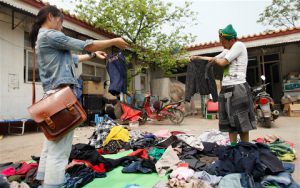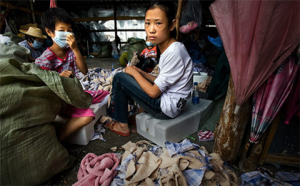When Sherry Poon set up her childrenswear clothing business, Wobabybasics, nine years ago, finding eco-friendly factories in China was a struggle, and finding organic cotton suppliers was nearly impossible.
“We originally wanted everything to be both sourced and made in China, and show people that products made in China do not have to be substandard,” she said. “I think I interviewed between 60 and 80 different production factories. I ended up having to import my organic cottons, although everything is still manufactured in China.”
A decade later, momentum is growing for the country’s green manufacturing. A record number of eco-friendly manufacturers showed up at the 2017 Intertextile trade show in Shanghai, although they’re still a niche in a very large market.
“For the first year they actually labelled which factories used eco or organic textiles, so they were easier to find,” says Poon. “Although we’re still talking maybe just twelve companies, out of thousands there.”
A commitment to sustainability is increasingly recognised in China. Wobabybasics, which uses entirely sustainable materials, was hailed as a top sustainable clothing brand by non-governmental organisation Green Initiatives, and studies have shown Chinese consumers are more and more willing to spend on green clothes and products.
Making sustainability the norm
Green manufacturing is no longer the domain of specialist brands.
Hong Kong-based textiles giant Esquel, the world’s largest shirt maker, has put been putting sustainability at the centre of its business. With sales of US$1.3 billion (8.5 billion yuan) last year, Esquel manufactures over 100 million garments annually for retailers including Marks & Spencer, Ralph Lauren, and Tommy Hilfiger, and has been focusing on building a more sustainable business for both staff and the environment.
“This industry has a very bad reputation when it comes to labour abuses, and being able to employ people at the bottom of the pyramid,” says Edgar Tung, head of global garment operations, Esquel Group. “We really wanted to reduce our impact on the environment and convert people’s perceptions about this industry.”
The textile and clothing industry has a long way to go to improve its green credentials. It is the second largest polluting industry globally after oil, accounting for 12.8 million tonnes of textile waste each year, while in China, 17-20% of the world’s industrial pollution and 2.5 billion tonnes of waste water are from textile dyeing and treatment alone each year.
Esquel says it is determined to show that manufacturing doesn’t have to be fuelled by cheap migrant labour and cost-cutting. A new US$300m garment factory in Guilin has low-energy measures such as natural ventilation, and a commitment to zero discharge of wastewater.
Their existing garment factories already offer above industry average wages, childcare facilities, kindergartens, paid overtime and a commitment to no night shifts, in a series of measures to improve staff conditions, as well as actively promoting staff internally.
In the last ten years, the company claims to have reduced energy consumption per garment by 45% and water consumption by 64%. A recent Corporate Information Transparency Index, which evaluated 267 brands in China, ranked Esquel as the second-best company textile and apparel company for its green supply chain, and fourth greenest among all companies.
“There’s always the perception there’s a cost to sustainability – but in the long run, there’s actually a lot more benefit,” says Tung. “There are a lot of customers that come to us not because we are the cheapest, but because they know we practice green manufacturing and are good to our people.
Customers come to us because they know we practice green manufacturing and are good to our people
At the recent Integral Conversation sustainability conference in Guilin, organised by Esquel, some of China’s biggest names came together to outline their work in green production. Conglomerate Far Eastern, which has operations in ten major industries including textiles, construction and retail, outlined how it has shifted focus to green materials, including what they claim is the world’s first 100% bio-polyester shirt.
“This is the way of the future,” Douglas Tong Hsu, chairman and CEO of Far Eastern Group, told the Guilin conference. “We are focused particularly on reduced-chemical products and recycling waste products. Where we have to use new material, we want them to be green materials.”
The government is also lending its support to sustainable manufacturing, inaugurating the Green Manufacturing Association of China this year, and driving companies towards automation as part of the ambitious Made in China 2025 plan to modernise the country’s factories. Some of the most polluting factories have already shut down, according to experts, often unwilling or unable to afford the costs of new environment requirements.
Brands such as Esquel and Far Eastern say they give their staff more training and pay higher rates than the market average to upskill the workforce, which increases productivity per employee.
At Shanghai trade conference Manufacturing in the Age of Experience in September, delegates heard how customers are demanding more professionalism and accountability from their manufacturers.
Zhenrui Zhao, of state-owned HBIS Tangsteel industry, outlined how his company tells customers which line their product is being assembled on so they can track it digitally, adding that a transparent approach to manufacturing is raising standards across the industry.
A long way to go
But significant barriers remain in the green manufacturing sector in China. There’s still a lack of awareness from consumers about how environmentally damaging the industry can be, plus the upfront costs of eco-friendly production are higher and it is difficult to secure reliable green suppliers.
Manufacturers also face stricter standards which haven’t always been adhered to, for example, the Global Organic Textile Standard (GOTS), which considers both environmental and social factors, requires refreshing every year.
And despite the increasing automation of factories, a preference for cheap labour is still common.
Research suggests most Chinese manufacturers are not ready for the next stage of digital, sustainable manufacturing, dubbed “Industry 4.0”. This new era of smart manufacturing is designed to move China up the value chain, increase productivity through the use of digital technology, and professionalise the manufacturing sector.
“I think around 60% of companies in China are still moving from 1.0 to 2.0, and there is a very weak base for lean management,” McKinsey’s Forest Hou told delegates in Shanghai, outlining how their research showed only 30% of Chinese manufacturing companies were ready to consider smart manufacturing. While more than half were “followers”, suggesting that the government’s “Made in China 2025” target to transform the manufacturing sector faces an uphill challenge.
Another risk to many manufacturers in the industry is rising wages and growing anger over pollution from consumers and state policy. Many multinational companies are moving production to lower-wage countries with less stringent regulations like Vietnam or Bangladesh. Myanmar’s clothing exports jumped from US$950 million to US$2.1bn between 2012 and 2016, while one analysis for the Federation of Hong Kong Industries trade group suggested the number of Hong Kong-owned factories in the Pearl River Delta fell by a third between 2006 and 2013.
Most of Esquel’s customers are high-end brands, who are under pressure from consumers to deliver better standards. However, Esquel insists that building their green manufacturing centre has actually saved them money in the long run, and that green manufacturing doesn’t have to be the domain of high-end goods.
Although there are more options available to her now, Poon says the green shift in Chinese manufacturing is still just beginning, and the only way to really trust a factory’s green credentials is to visit in person and check.
“China’s factories have had to change, educate themselves a little more, and push to not just be mass market production but one step higher quality – part of that is being more sustainable,” she adds. “It’s been ten years, but this year I’ve finally felt there is a change.”








